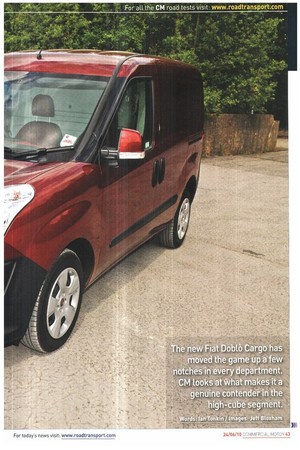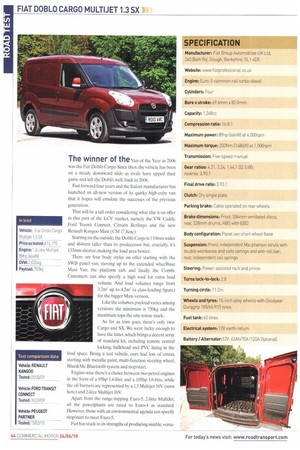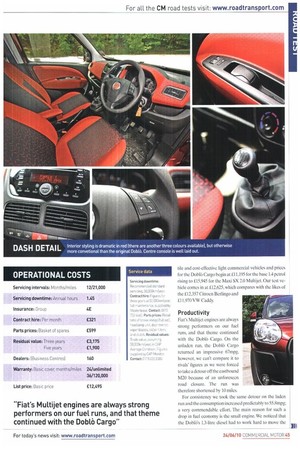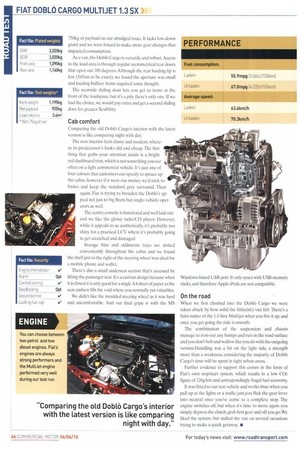e new Fiat Dobto Cargo has
Page 59

Page 60

Page 61

Page 62

If you've noticed an error in this article please click here to report it so we can fix it.
moved the game up a few ,otches in every department. CM Looks-at What makes it a genuine contender in the high-cube segment. The winner of they.. of the Year in 2006 was the Fiat Doble Cargo. Since then, the vehicle has been on a steady downward slide as rivals have upped their game and left the DoblO, well, back in 2006.
Fast forward four years and the Italian manufacturer has launched an all-new version of its quirky high-cube van that it hopes will emulate the successes of the previous generation.
That will be a tall order considering what else is on offer in this part of the LCV market, namely the VW Caddy, Ford Transit Connect. Citroen Berlingo and the new Renault Kangoo Maxi (CM 17 June).
Starting on the outside,the Doble Cargo is 110mm wider and 464mm taller than its predecessor but, crucially, it's 133mm shorter, making the load area boxier.
There are four body styles on offer starting with the SWB panel van, moving up to the extended wheelbase Maxi Van, the platform cab, and finally the Combi. Customers can also specify a high roof for extra load volume. And load volumes range from 3.2m3 up to 4.2m' (a class-leading figure) for the bigger Maxi version.
Like the volumes, payload varies among versions: the minimum is 750kg and the maximum tops the one-tonne mark.
As far as trim goes, there's only two: Cargo and SX. We were lucky enough to have the latter, which brings a decent array of standard kit, including remote central locking, bulkhead and PVC lining in the load space. Being a test vehicle, ours had lots of extras, starting with metallic paint, multi-function steering wheel, Blue&Me Bluetooth system and stop/start.
Engine-wise there's a choice between two petrol engines in the form of a 95hp 1.4-litre and a 105hp 1.6-litre, while the oil burners are represented by a 1.3 Multijet 16V (seen here) and 2-litre Multijet 16V.
Apart from the range-topping Euro-5, 2-litre MultiJet, all the powerplants are rated to Euro-4 as standard. However, those with an environmental agenda can specify stop/start to meet Euro-5.
Fiat has stuck to its strengths of producing nimble, versa tile and cost-effective light commercial vehicles and prices for the Doble Cargo begin at £.11,195 for the base 1.4 petrol rising to £.15,945 for the Maxi SX 2.0 Multijet. Our test vehicle comes in at £12,625, which compares with the likes of the £12,357 Citroen Beriingo and £11 ,970 VW Caddy.
Productivity
Fiat's Multijet engines are always strong performers on our fuel runs, and that theme continued with the Dob16 Cargo. On the unladen run. the Doblo Cargo returned an impressive 67mpg, however, we can't compare it to rivals' figures as we were forced to take a detour off the eastbound M20 because of an unforeseen road closure. The run was therefore shortened by 10 miles.
For consistency we took the same detour on the laden run and the consumption increased predictably to 55.8mpg; a very commendable effort. The main reason for such a drop in fuel economy is the small engine. We noticed that the Doble's 1.3-litre diesel had to work hard to move the 750kg of payload on our abridged route. It lacks low-down grunt and we were forced to make more gear changes that impacted consumption.
As a van, the Doblo Cargo is versatile and robust. Access to the load area is through regular asymmetrical rear doors that open out 180 degrees. Although the rear loading lip is low (545cm to be exact), we found the aperture was small and loading bulkier items required some thought.
The nearside sliding door lets you get to items at the front of the loadspace, but it's a pity there's only one. If we had the choice, we would pay extra and get a second sliding door for greater flexibility.
Cab comfort
Comparing the old Doblb Cargo's interior with the latest version is like comparing night with day.
'Me new interior feels classy and modern, whereas its predecessor's looks old and cheap. The first thing that grabs your attention inside is a bright red dashboard trim, which is not something you see often on a light commercial vehicle. It's just one of four colours that customers can specify to spruce up the cabin, however if it were our money we'd stick to basics and keep the standard grey surround. Then again, Fiat is trying to broaden the Doblo's appeal not just to big fleets but single-vehicle operators as well.
The centre console is functional and well laid-out and we like the glossy radio/CD player. However, while it appeals to us aesthetically, it's probably too shiny for a practical LCV where it's probably going to get scratched and damaged.
Storage bins and oddments trays are dotted conveniently throughout the cabin and we found the shelf just to the right of the steering wheel was ideal for a mobile phone and wallet.
There's also a small underseat section that's accessed by lifting the passenger seat. It's a curious design because when it is closed it is only good for a single A4 sheet of paper as the seat cushion fills the void where you normally put valuables.
We didn't like the moulded steering wheel as it was hard and uncomfortable. And our final gripe is with the MS Windows-based USB port. It only syncs with USB memory sticks, and therefore Apple iPods are not compatible.
On the road
When we first climbed into the Dobla Cargo we were taken aback by how solid the little(ish) van felt. There's a faint natter of the 1.3-litre Multijet when you fire it up, and once you get going the ride is smooth.
The combination of the suspension and chassis manage to iron-out any bumps and ruts in the road surface and you don't bob and wallow like you do with the outgoing version.Handling was a bit on the light side, a strength more than a weakness, considering the majority of DoblO Cargo's time will be spent in tight urban areas.
Further evidence to support this comes in the form of Fiat's own stop/start system, which results in a low CO2 figure of 126g/km and correspondingly frugal fuel economy.
It was fitted to our test vehicle and works thus: when you pull up at the lights or a traffic jam.you flick the gear lever into neutral once you've come to a complete stop. The engine switches off, but when it's time to move again you simply depress the clutch, grab first gear and off you go. We liked the system, but stalled the van on several occasions trying to make a quick getaway. •












































































































































